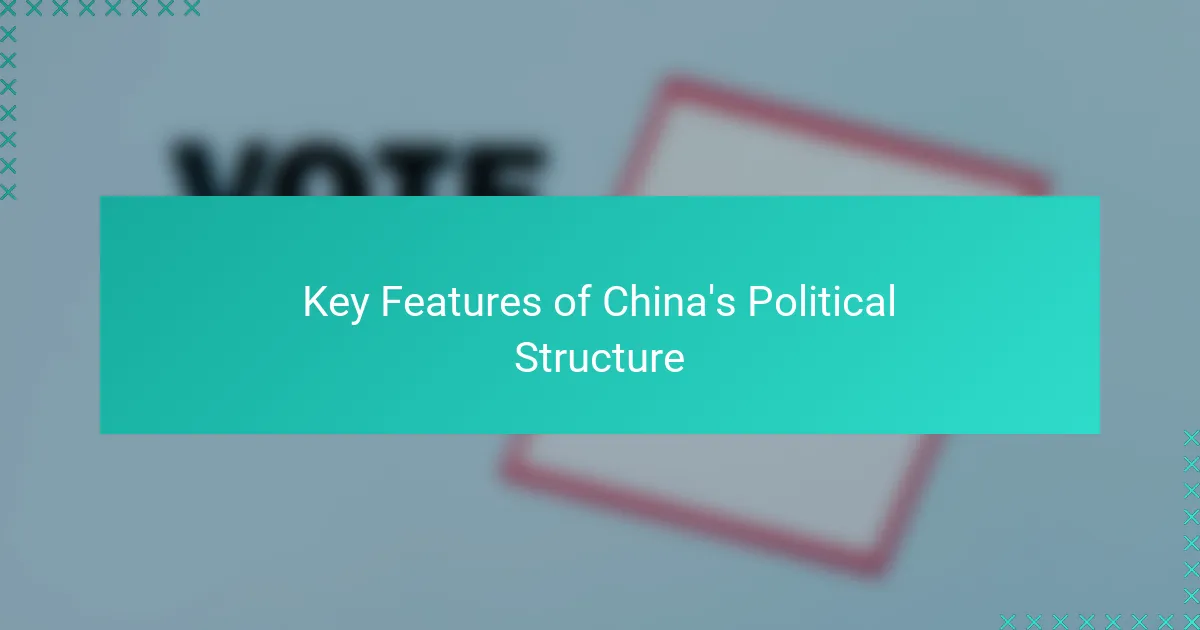Key takeaways
- China’s governance model features a single-party system, primarily dominated by the Chinese Communist Party, affecting decision-making and citizen engagement.
- The balance between centralized control and local adaptation allows for responsive governance but raises concerns about accountability and public participation.
- China’s approach emphasizes rapid economic development and infrastructure projects, influencing global trade dynamics and offering alternative governance ideas to other nations.
- The model highlights the tension between stability and individual voices, prompting questions about sustainability in the face of growing social complexities.

Understanding Governance Models in Politics
Governance models are frameworks that shape how power and authority are exercised within a political system. They influence decision-making processes, citizen participation, and accountability. Have you ever wondered why some governments seem more effective or stable than others?
From my experience studying global politics, understanding these models requires looking beyond labels like “democracy” or “authoritarianism.” It’s about the actual mechanisms and values that guide a nation’s governance. For example, the balance between centralized control and local autonomy can drastically change how policies impact people’s daily lives.
Reflecting on this, I often think about how these models resonate emotionally with citizens—do people feel represented and heard, or powerless and frustrated? This emotional connection is crucial because it shapes both legitimacy and social cohesion, which are often overlooked aspects when analyzing political systems purely on paper.

Overview of China’s Governance System
China’s governance system centers on a single-party leadership, mainly the Chinese Communist Party (CCP), which holds ultimate authority. I’ve found this concentration of power quite different from multiparty democracies, raising questions about how governance efficiency balances with political plurality.
What strikes me is the system’s mix of centralized control with localized implementation. From my observations, while the top leadership sets broad strategic goals, local governments often have room to adapt policies to fit regional needs, which adds a layer of complexity I hadn’t fully appreciated before.
Thinking about citizen engagement here, I wonder how ordinary people perceive their role in this structure. Though formal political participation may be limited, social stability and rapid development appear to foster a sense of pride and confidence among many Chinese citizens, at least from what I’ve read and seen.

Key Features of China’s Political Structure
One thing that stands out to me about China’s political structure is its emphasis on the Chinese Communist Party’s (CCP) leadership. It’s not just a ruling party; it’s embedded deeply into every level of governance, guiding policies and decisions across the country. This single-party dominance creates a unique political rhythm that I’ve noticed contrasts sharply with pluralistic systems where power shifts more frequently.
Another feature I find fascinating is the interplay between centralized authority and localized governance. While the CCP directs the big picture, local officials have some discretion to implement policies based on regional realities. I’ve seen this tension firsthand in reports on economic reforms, where local governments sometimes innovate within the boundaries set by the central leadership.
It makes me wonder—how does this structure affect accountability and responsiveness? From what I’ve gathered, the system values stability and long-term planning, but that can sometimes mean individual voices get lost in the process. Still, the apparent ability to deliver consistent development seems to give many people a sense of trust and order, even if the political voice is more muted.

Comparing China with Other Models
When I compare China’s governance with Western democracies, the contrast is striking. In democracies, frequent elections and multiple parties create a dynamic but sometimes chaotic political scene, whereas China’s single-party rule offers continuity and a long-term vision that many find reassuring. But does that stability come at the cost of public debate and citizen input? From my experience, that trade-off is central to understanding how different societies prioritize governance values.
Looking at other authoritarian regimes, China distinguishes itself through its blend of economic pragmatism and political control. Having studied cases where authoritarianism leads to stagnation or repression, I see China’s model as one where economic performance legitimizes governance, even if political freedoms are limited. It makes me wonder—how sustainable is this balance when social expectations and complexities grow?
I’ve also noticed that hybrid systems, like some in Southeast Asia, try to blend competitiveness with centralized authority, but they often struggle with inconsistent policy execution. China’s model, by contrast, benefits from strong party discipline and a clear chain of command. This cohesion can drive massive projects and reforms efficiently, yet I question whether such concentration of power risks overlooking grassroots concerns that emerge beyond the official channels. Have you seen examples where this tension played out? I certainly have, especially when local innovations either thrive or get stifled depending on central approval.

Impacts of China’s Governance Globally
China’s governance model wields significant influence far beyond its borders. From my perspective, its emphasis on centralized planning enables swift decision-making that powers global infrastructure projects like the Belt and Road Initiative. But I often wonder—how does this top-down approach shape the sovereignty and development trajectories of participating countries?
In my experience analyzing global politics, China’s governance has transformed international trade dynamics. Its ability to coordinate state-led investments and regulate industries creates a competitive environment that challenges traditional economic powers. Yet, this raises questions about fairness and the role of political influence in global markets—are other nations adapting or resisting this new reality?
What strikes me deeply is how China’s model exports not just goods, but governance ideas too. Some governments seem attracted to the promise of stability and rapid growth over liberal democratic processes. This diffusion of governance norms sparks debates about global political futures. Have you noticed how this reshapes alliances and ideological battles on the world stage? I certainly have, and it’s a development worth watching closely.

Personal Insights on China’s Model
I’ve always found China’s governance model both intriguing and challenging to fully grasp. What fascinates me most is how the system manages to combine strict top-down control with a surprising degree of local adaptation. It reminds me of a complex orchestra where the conductor sets the tempo, but individual musicians add their unique flair within those boundaries.
Reflecting on this, I can’t help but wonder about the everyday experiences of citizens living under such a system. Do they feel a genuine connection to the state, or does the centralized power create an invisible barrier? From what I’ve observed, many seem to derive a sense of security and pride from the stability and progress they witness, even if political expression isn’t as open as in other countries.
At the same time, I often ask myself how sustainable this model is when faced with growing social complexities and demands for inclusivity. My experience tells me that while the system’s efficiency and long-term planning are commendable, striking the right balance between control and responsiveness will be crucial for its future legitimacy.

Practical Lessons from China’s Governance
China’s governance offers practical lessons in how centralized authority can drive large-scale development with impressive speed and coherence. I recall reading about infrastructure projects completed in record time, and it made me think: could this efficiency be replicated elsewhere without such concentration of power? It certainly shows that a clear chain of command can minimize bureaucratic delays and push ambitious goals forward.
But then, I wonder about the human side of all this effectiveness. From what I’ve learned, local officials often have some room to adapt policies, which suggests that flexibility within a rigid framework can foster innovation. Have you noticed how some regions in China experiment with reforms that later influence national policy? This balance between control and local initiative is a practical approach I find quite insightful.
Yet, this model also raises questions about accountability. When power is so concentrated, how do you ensure that the voices of ordinary citizens aren’t overlooked? I’ve seen instances where stability and rapid growth seem to build trust, but at what cost to public participation? These tensions in China’s governance provide valuable food for thought, especially for those of us interested in how political systems tackle complexity in practice.
